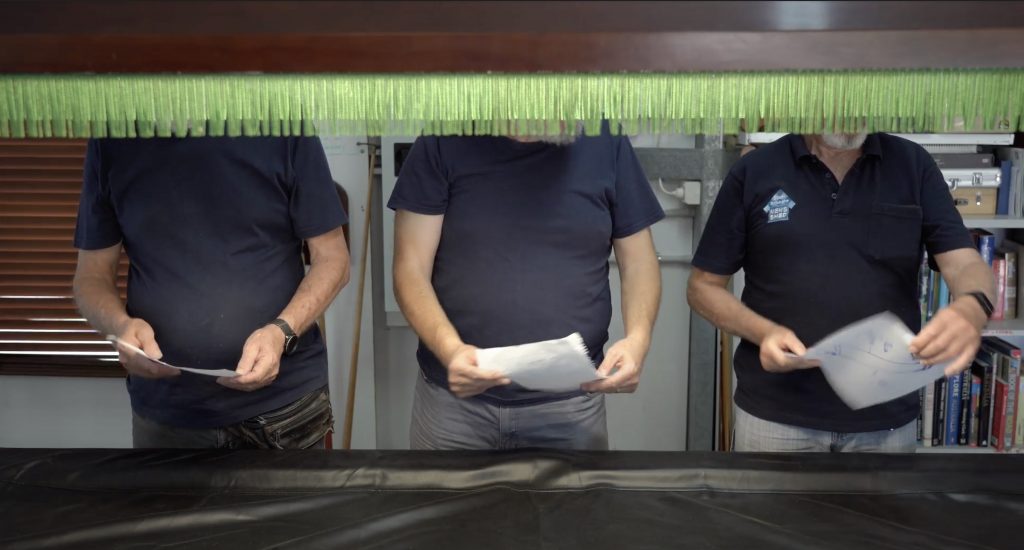Azadeh Hamzeii: A Tool is a Tool

In A Tool is a Tool by Azadeh Hamzeii, the narrative oscillates between scenes captured by two parties: Azadeh’s mother in Tehran and the artist in Brisbane. The work hinges on finding a cotton fluffing tool (bow) in Iran and constructing it outside of its country of origin, in a Men’s Shed in Australia. The story morphed into zany ritualistic acts between the artist and the males in the shed referencing a Cinéma Verité performative style, where connections between her and male performers during creation of the tool become the purpose. The result is not a documentary about making a cotton fluffing bow; it is about a wordless dialogue between generations and craft histories.
The artist would like to express her gratitude to George Wolf for the dedication, expertise and care throughout this project and to the South Brisbane Men’s Shed community and Alan Elphinstone for their support. A special mention for Dr. Chris Bennie, the artist’s mentor for the encouragement and his insightful and constructive feedback during the concept planning and execution of the work.
Azadeh Hamzeii, by Reina Takeuchi
Azadeh Hamzeii’s nuanced and performative practice explores her personal and familial connections between two countries: Iran and Australia. A Tool is a Tool documents two intertwined narratives that revolve around a cotton fluffing tool constructed across continents. The first narrative is that of Hamzeii’s endeavours to construct a cotton fluffing tool at a workshop in the heart of Brisbane. The second narrative involves Hamzeii’s mother traversing regions of Tehran in search of cotton fluffing workers. The stories cross several borders, times and spaces, from quiet, dry Brisbane backyards and men’s sheds, to the arid and dusty streets of Tehran where Hamzeii’s mother filmed her cotton-fluffing research on shaky, lo-fi FaceTime phone recordings.
Originally used in Iran to fluff cotton, the tool Hamzeii constructed in A Tool is a Tool is one that has been outmoded in favour of the more efficient and increasingly dangerous process of machination: feeding cotton into a churning machine with one’s bare hands. Here, Hamzeii provides us with rare glimpses into the connections forged using this tool. Connections not only between Hamzeii and her mother, but also those between the men she has documented and the unassuming rituals they have with the complex tools with which they work.
The construction of the tool in Queensland becomes akin to magic, a process Hamzeii frames with performative specificity. The workshop is a place of play, male bonding, camaraderie and innovation in the Australian context. It represents an escape from the rigours of life, normalcy and responsibility, providing with it, a place for masculine dreaming and creativity. In Tehran, the craftsmanship of cotton fluffing speaks directly to a ruthless economy, the brutal realities of relentless labour and the undeniable death of magical thinking in the face of extreme adversities.
Yet cotton fluffing is as beautiful as it is laborious. The compressed cotton expands and becomes fluffy once again, ready to be used and stuffed into material. Hamzeii’s mother remarks on the graceful quality of the cotton as she documents Iranian men tearing the fluffed cotton from machines, “It looks like the cotton is dancing and flying with your music.” In many ways, Hamzeii has at once succeeded in creating both a relic from another time that is also entirely different, a uniquely crafted object reconstructed ad-hoc from memories and online images. A transformation, a Frankenstein of its original and something else – something in-between the past and present. She has created an object in homage of what was, in a place that could not be any further removed from its country of origin.
It’s not really about the tool, is it? It is about the process. It’s about a process involving FaceTime conversations, planning, recreating and constructing – a process of holding on to and maintaining the tenuous threads between family, homelands, ways of life, craft histories and dying traditions.
This project was commissioned by 4A Centre for Contemporary Asian Art in collaboration with Metro Arts (Brisbane), with an exhibition component to be realised in December 2021.
With a focus on the dialogues between the individual and the universal, Azadeh Hamzeii mines her personal history and cultural background as an Iranian based in Meanjin (Brisbane). Drawing from a range of subjects and materials including votive offerings, beeswax, fishing hooks, her father’s old film negatives and Keffiyeh, Hamzeii investigates the localised significance of objects and the potential to elevate their meaning, creating a broader human narrative. She is alumni of Queensland College of Art, Griffith University, held a Bachelor of Fine Arts majored in Interdisciplinary Sculpture Making and a Diploma of Photography from Tehran University, Fine Arts Department.
Reina Takeuchi is an Australian-Japanese artist-researcher, dance maker and curator currently working at 4A as an Assistant Curator. Influenced by her experiences living peripatetically across Asia and South-East Asia, Takeuchi uses an auto-ethnographic approach with her artistic research and performance processes. Her practice spans across visual arts, choreography, curatorial projects, written publications and creative facilitation.
In 2020, 4A Digital is


